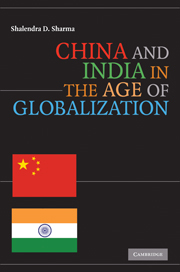Book contents
- Frontmatter
- Contents
- Acknowledgments
- Acronyms
- Political Map of China
- Political Map of India
- Introduction: China and India in the Age of Globalization
- 1 Prelude to Globalization: China (1949–1978) and India (1947–1991)
- 2 China and India Embrace Globalization
- 3 China: Strategies and Patterns of Global Integration
- 4 India: Strategies and Patterns of Global Integration
- 5 Sino-Indian Relations: Partners, Friends, or Rivals?
- 6 India and the United States: From Estrangement to Engagement
- 7 The Rise of China and Its Implications for the United States
- 8 China and India: Future Challenges and Opportunities
- Bibliography
- Index
2 - China and India Embrace Globalization
Published online by Cambridge University Press: 22 January 2010
- Frontmatter
- Contents
- Acknowledgments
- Acronyms
- Political Map of China
- Political Map of India
- Introduction: China and India in the Age of Globalization
- 1 Prelude to Globalization: China (1949–1978) and India (1947–1991)
- 2 China and India Embrace Globalization
- 3 China: Strategies and Patterns of Global Integration
- 4 India: Strategies and Patterns of Global Integration
- 5 Sino-Indian Relations: Partners, Friends, or Rivals?
- 6 India and the United States: From Estrangement to Engagement
- 7 The Rise of China and Its Implications for the United States
- 8 China and India: Future Challenges and Opportunities
- Bibliography
- Index
Summary
This chapter provides a broad analysis of how and why China and India opened themselves to the global economy. It provides a comprehensive review of the various policies and programs that were put in place to facilitate each country's integration into the international economic system. The following pages explore not only the politics behind the policy making and how this has influenced and determined the nature, substance, and depth of the various pro-market policies, but also why and how the various policies and programs have evolved or been revised to meet the changing political and economic circumstances. The chapter shows that whereas China – following Deng's famous maxim, “crossing the river by groping for stones” – gradually and sequentially adapted its reform policies to the fast-changing domestic and global political economy and seized opportunities as they arose, India's liberalization program, literally forced on the country's political elites by a fast hemorrhaging economy, was hastily introduced. After the initial burst, pro-market policies have followed a seemingly meandering path – more a reflection of the contingencies of the country's democratic politics than economic prudence.
Moreover, the chapter sheds insight on the perennial political economy question: why was a certain approach to global economic integration – namely, “gradualism” – privileged over “shock therapy”? Why, unlike the former Soviet Union and its Eastern bloc, did market reforms and global economic integration in China not result in economic and political implosion, but rather political stability and unprecedented economic growth?
- Type
- Chapter
- Information
- China and India in the Age of Globalization , pp. 54 - 90Publisher: Cambridge University PressPrint publication year: 2009

